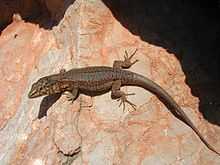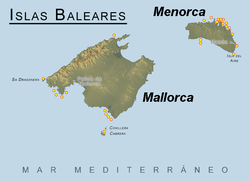Lilford's wall lizard
| Lilford's wall lizard | |
|---|---|
 | |
| Conservation status | |
| Scientific classification | |
| Kingdom: | Animalia |
| Phylum: | Chordata |
| Class: | Reptilia |
| Order: | Squamata |
| Family: | Lacertidae |
| Genus: | Podarcis |
| Species: | P. lilfordi |
| Binomial name | |
| Podarcis lilfordi (Günther, 1874) | |
 | |
| Range | |
The Lilford's wall lizard (Podarcis lilfordi) is a species of lizard in the family Lacertidae. It is endemic to the Balearic Islands, Spain.
Its natural habitats are temperate Mediterranean-type shrubby vegetation, rocky areas, and rocky shores. Originally distributed throughout the Balearics, the introduction of alien species which started with the Romans has confined the species to the uninhabited islets around the major islands, on almost each of which a local subspecies has evolved. It is threatened by habitat loss. It is named in honour of Thomas Powys, 4th Baron Lilford, a British ornithologist who studied the fauna of the Balearics.
Description
Lilford's wall lizard grows to a maximum snout-to-vent length of 8 cm (3 in) but adults are usually a little smaller than this. The tail is about 1.8 times as long as the body. It is a robust streamlined lizard with a short-head and rounded body with smooth, unkeeled scales. The dorsal surface is usually greenish or brownish but varies much between different island subpopulations. There is usually a pale dorso-lateral stripe and there may be several dark streaks or three dark lines running along the spine. The flanks may be slightly reticulated and the underside is white, cream or pinkish. The throat may be blotched with darker colour. Juveniles sometimes have a blue tail.[2]
Distribution and habitat
Lilford's wall lizard is native to the islands of Menorca and Mallorca in the Balearic Islands, the Cabrera Archipelago to the south of Mallorca, and the neighbouring rocky islets. However it has been extirpated from the two large islands and is now only present on the islets. It is found at low altitudes.[1] It is a mainly ground-dwelling species and largely inhabits rocky areas and scrubland, although it is found in woodland on Cabrera.[2]
Behaviour
Lilford's wall lizard is a relatively tame lizard and easy to approach. It mainly feeds on insects, spiders and other arthropods, snails and some vegetable matter. This includes flowers and fruits, nectar and pollen. Some plants endemic to the Balearic Islands depend on this lizard for pollination.[2] Other plants known to be pollinated by it include the mastic tree Pistacia lentiscus, rock samphire Crithmum maritimum, wild leek Allium ampeloprasum, clustered carline thistle Carlina corymbosa and the sea daffodil Pancratium maritimum.[3] It is opportunistic around birds' nests in the use of scraps of food that have been regurgitated by gulls for their chicks. It also sometimes moves to the vicinity of nests of the Eleonora's falcon (Falco eleonorae) and feeds on the remains of its prey and the flies that accumulate around the nesting site. It is sometimes cannibalistic, eating juveniles and the tails of other lizards of its own species.[2]
Breeding takes place in the summer and females may lay up to three clutches of one to four eggs with an average mass of 63 g (2.2 oz), large for a lizard of this size. These hatch in about eight weeks and the emerging young measure about 3 to 3.5 cm (1.2 to 1.4 in) from snout to vent.[4]
Status
The population of this lizard seems to be in decline. It was at one time very numerous on Menorca and Mallorca but is no longer found on either. This extirpation may have been caused by the proliferation of cats and by other introduced predators, possibly the false smooth snake (Macroprotodon cucullatus) and the weasel (Mustela nivalis). Its total area of occupancy on all the small islands on which it is now present is less than 500 km2 (193.1 sq mi) so the IUCN lists it as being "Endangered".[1]
Subspecies
There are twenty-seven subspecies many of which are found on only a single island:[5]
- Podarcis lilfordi lilfordi (Günther, 1874). Found in the Aire islet, off the southeastern coast of Minorca.
- Podarcis lilfordi addayae (Eisentraut, 1928).
- Podarcis lilfordi balearica (Bedriaga, 1879).
- Podarcis lilfordi brauni (Müller, 1927). Found in Colom islet, off Minorca.
- Podarcis lilfordi carbonerae Perez Mellado and Salvador, 1988. Own to Carbonera islet, off Minorca.
- Podarcis lilfordi codrellensis Perez Mellado and Salvador, 1988. Own to Binicondrell islet, off the southern coast of Minorca.
- Podarcis lilfordi colomi (Salvador, 1980). Found in Colomer islet, off northeast Minorca.
- Podarcis lilfordi conejerae (Müller, 1927).
- Podarcis lilfordi espongicola (Salvador, 1979)
- Podarcis lilfordi estelicola (Salvador, 1979)
- Podarcis lilfordi fahrae (Müller, 1927)
- Podarcis lilfordi fenni (Eisentraut, 1928). Own to Sanitja islet, off northern Minorca.
- Podarcis lilfordi gigliolii (Bedriaga, 1879). In Dragonera islet, off north of Majorca.
- Podarcis lilfordi hartmanni (Wettstein, 1937)
- Podarcis lilfordi hospitalis
- Podarcis lilfordi imperialensis (Salvador, 1979)
- Podarcis lilfordi isletasi
- Podarcis lilfordi jordansi (Müller, 1927)
- Podarcis lilfordi kuligae (Müller, 1927)
- Podarcis lilfordi nigerrima (Salvador, 1979)
- Podarcis lilfordi planae (Müller, 1927)
- Podarcis lilfordi probae (Salvador, 1979)
- Podarcis lilfordi porrosicola Pérez Mellado and Salvador, 1988. Own to the Porros islet, north of Minorca.
- Podarcis lilfordi rodriquezi (Müller, 1927) – Ratas Island lizard. Formerly Ratas Island, in Mahón's harbour (Minorca). Extinct after island was demolished in harbour expansion.
- Podarcis lilfordi sargantanae (Eisentraut, 1928). Found in the islets located by the north coast of Majorca (Sargantana, Ravells, Bledes and Tusqueta).
- Podarcis lilfordi toronis (Hartmann, 1953)
- Podarcis lilfordi xapaticola (Salvador, 1979)
References
- ↑ 1.0 1.1 1.2 Valentin Pérez-Mellado, Iñigo Martínez-Solano (2009). "Podarcis lilfordi". IUCN Red List of Threatened Species. Version 2013.2. International Union for Conservation of Nature. Retrieved 2014-01-01.
- ↑ 2.0 2.1 2.2 2.3 Arnold, E. Nicholas; Ovenden, Denys W. (2002). Field Guide: Reptiles & Amphibians of Britain & Europe. Collins & Co. p. 157. ISBN 9780002199643.
- ↑ Perez-Mellado, Valentin; Ortega, Felisa; Martin-Garcia,Sandra; Perea, Ana; Cortázar, Gloria (2000). "Pollen load and transport by the insular lizard Podarcis lilfordi (Squamata, Lacertidae) in coastal islets of Menorca (Balearic Islands, Spain)". Israel Journal of Zoology 46 (3): 193–200. doi:10.1560/QMY9-PXWF-AG43-RP6F.
- ↑ Castilla, Aurora M.; Bauwens, Dirk (2000). "Reproductive Characteristics of the Island Lacertid Lizard Podarcis lilfordi". Journal of Herpetology 34 (3): 390–396. JSTOR 1565362.
- ↑ Honegger, Rene E.; Böhme, W. (1981). Threatened amphibians and reptiles in Europe. p. 116.
| Wikimedia Commons has media related to Podarcis lilfordi. |
